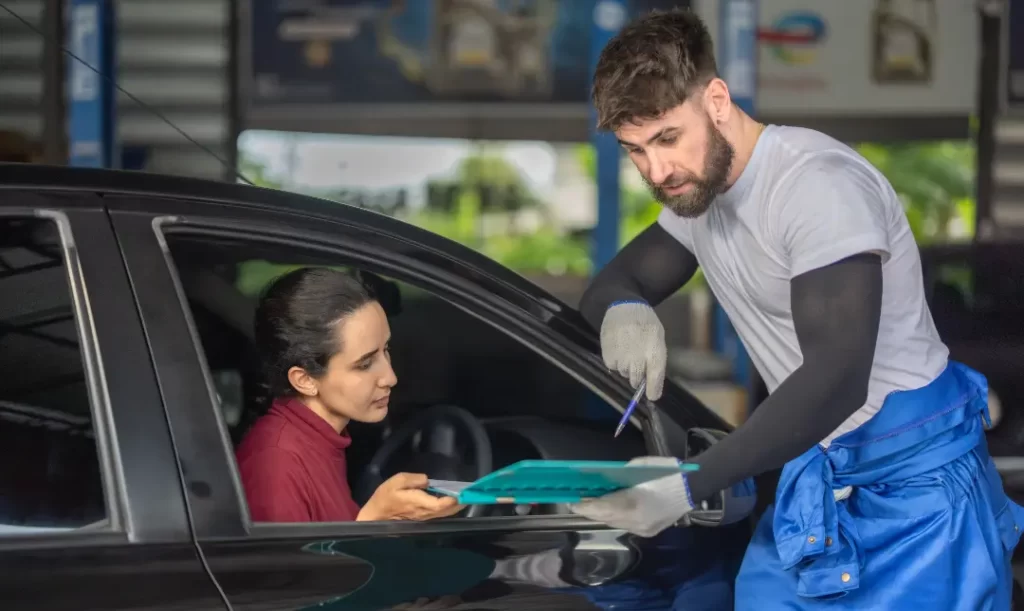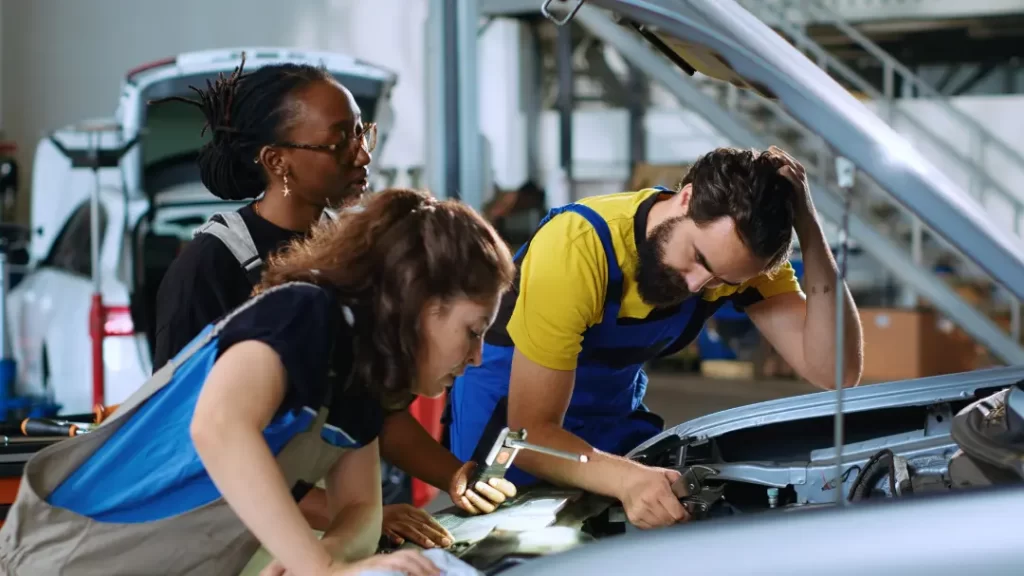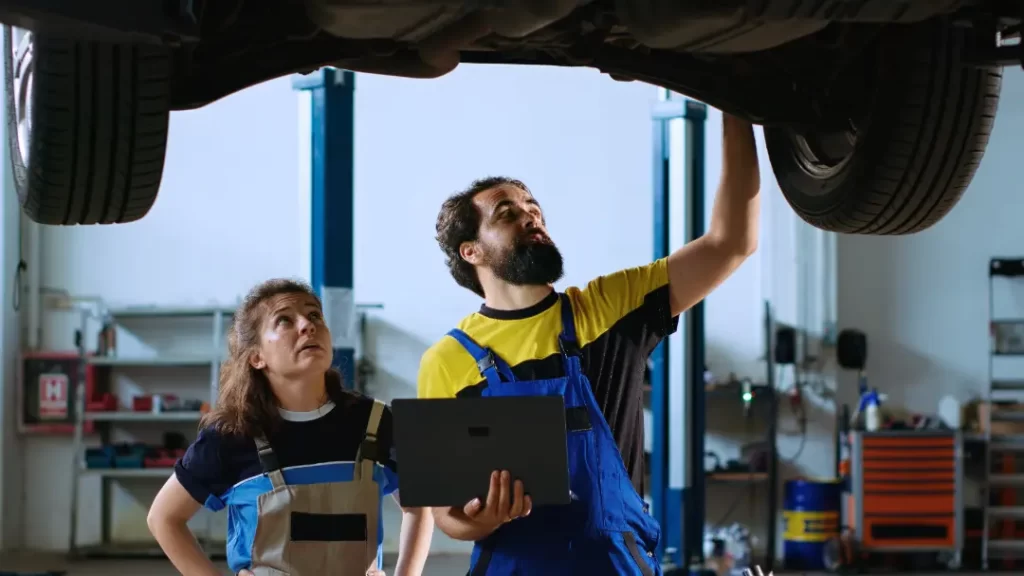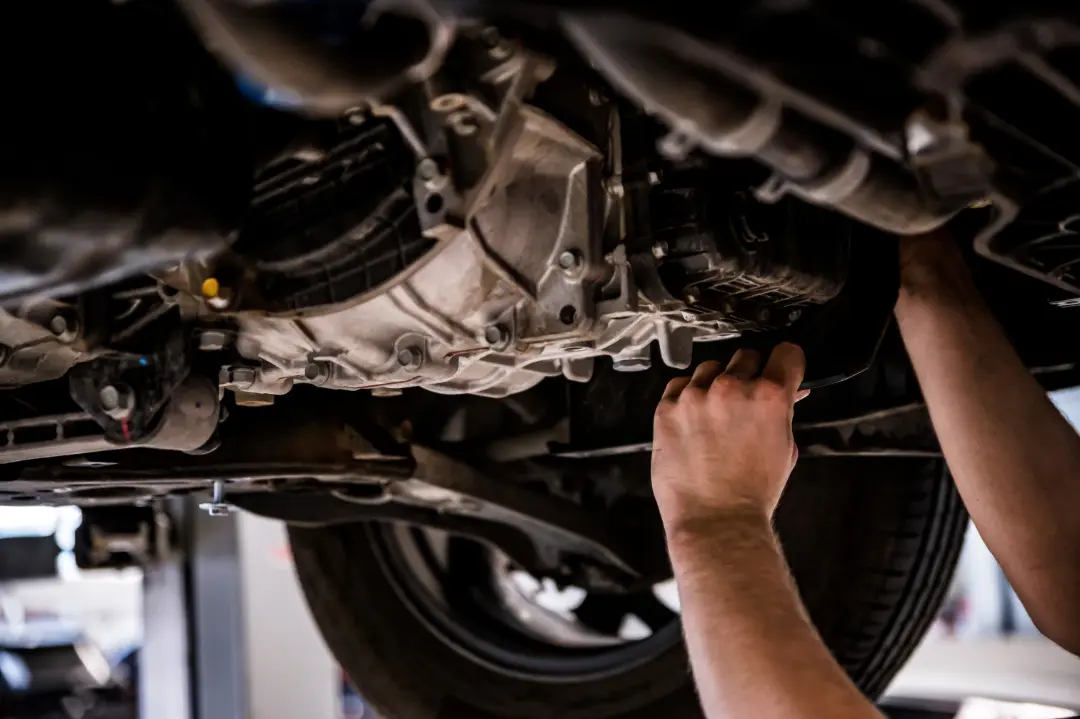If you’ve recently purchased a new car in the UK, you may wonder, “When will a new car need its first mot?” The If you’ve recently purchased a new car in the UK, you may wonder, “When will a new car need its first mot?” The answer is straightforward: your new car will require its first MOT once it’s three years old from the car’s registration date. Understanding when your vehicle needs to be tested ensures it complies with safety and environmental standards mandated by law.
This article guides you through the timeline, exceptions, and preparations you must make for that first MOT test, giving you clarity and preventing pitfalls.
Key Takeaways
- New cars in the UK must have their first MOT test within three years of registration, with Northern Ireland requiring it after four years to ensure they meet safety and environmental standards.
- Penalties for missing the MOT test can result in fines up to £1,000, and driving with a ‘dangerous’ vehicle can lead to points on the license or a driving ban; keeping track of your MOT due date and mot expiry date is essential.
- Sovereign Motor Engineers specialises in offering MOT tests, repairs, and maintenance for modern and classic cars. Its professional services extend to preparing vehicles for their MOT tests.
Understanding the First MOT Test
What is an MOT Test?
An MOT test is a mandatory annual examination that assesses a vehicle’s roadworthiness, safety, and environmental standards. Conducted by authorised MOT testing centres, this test is crucial for ensuring that vehicles meet the required standards to operate safely on public roads. During the MOT test, various aspects of the vehicle are inspected.
This comprehensive check helps identify any issues that could compromise the vehicle’s safety or environmental compliance.
Why is the First MOT Test Important?
The first MOT test is particularly significant for new cars, as it ensures that the vehicle remains roadworthy after three years of use. Over time, normal wear and tear can affect a new car’s performance and safety. The first MOT test checks for any issues that may have developed, safeguarding the safety of the driver and other road users by preventing unfit vehicles from being on the road.
This initial test marks the transition from the vehicle’s initial period of reliability to a phase where regular checks are essential to maintain its roadworthiness.
Determining Your Car’s First MOT Timeline
A valid MOT (Ministry of Transport) certificate is a must-have for every vehicle owner in the UK. The test ensures that your car meets the required safety and environmental standards, allowing you peace of mind on the road. The first MOT test is critical—it marks the end of your vehicle’s “honeymoon” period and the start of its journey as a seasoned road warrior. But when exactly is this milestone?
New UK cars must undergo their first MOT test within three years of their car’s registration date. This requirement ensures that vehicles meet safety and environmental standards. This three-year exemption is based on the expectation that new cars will remain roadworthy during this period. After the initial test, annual MOT tests are required to ensure ongoing road safety. However, not all regions follow the same rules. For instance, Northern Ireland requires new cars to undergo their first MOT after four years. Let’s dive a little deeper to help you navigate these regional differences and understand your vehicle’s registration date.

Understanding Registration Dates
For every car owner, the car’s registration date serves as the starting point for the MOT timeline. It’s the date when your car officially became yours and started its life on the road. This date is crucial because it determines when your vehicle must undergo its first MOT test. But where can you find this date?
Your car’s registration date is on your V5C registration document, also known as the logbook. This document is sent to you after you purchase your car and contains vital information about your vehicle, including its registration date. If you don’t have your V5C document, don’t worry—the DVLA’s vehicle information service can also provide you with your car’s registration date.
So, now that you’ve got your registration date and know when your first MOT is due let’s explore some exceptions and regional differences.
Exceptions and Regional Differences
In Great Britain, most cars, vans, and motorcycles should have their first MOT after three years. However, Northern Ireland dances to a different tune, requiring new cars to undergo their first MOT after four years. This regional difference can sometimes be confusing, especially for those who move from one region to another. But why does this difference exist?
The variations in the first MOT requirements across different regions stem from other interpretations of the Road Traffic Act 1988. This law stipulates the initial timing for an MOT but permits ministers to adjust this period, provided it is at most ten years. While there have been discussions about revising the initial MOT requirement from three to four years in the UK, the change still needs to be implemented following a 2016 consultation. Technological advancements in vehicle manufacturing and safety systems have further prompted discussions on whether the current three-year timeframe for the first MOT remains necessary.
Now that we’ve understood the timeline and regional differences, let’s book your first MOT test.
Booking Your First MOT Test with Sovereign Motor Engineers
When booking your first MOT test, you want to entrust your vehicle to a reliable, experienced service provider. That’s where Sovereign Motor Engineers (SME) comes in. Established in 2010, SME has made a mark in the auto service industry with high diagnostic and repair standards. Our services include:
- MOT testing
- Car servicing
- Repairs
- Car sales for various makes and models
After the test, you will receive an MOT test certificate, which is crucial for proving your vehicle’s compliance with safety standards.
Whether you’ve just bought a new car or are the proud owner of a classic vehicle, our highly knowledgeable and experienced technicians can provide the expert service you need. We understand that your car is more than just a means of transportation—it’s a part of your lifestyle and, in many ways, an extension of your personality. That’s why we offer specialised services for classic and vintage cars, combining our passion and expertise to ensure your precious vehicle receives the care it deserves.
But how do you book your MOT test with us? Let’s find out.
Why Choose Sovereign Motor Engineers
At Sovereign Motor Engineers, we believe in combining expertise with a personal touch. With over a decade of experience in MOT testing and other vehicle services, we have the skills and knowledge to ensure your car is in safe hands. Our technicians are highly qualified and capable of diagnosing and repairing vehicles to high standards. We take pride in our work and treat every car as our own. As a trusted partner of the vehicle licensing agency, we are committed to maintaining the highest standards in our services.
But what truly sets us apart is our customer service. We’re known for our honesty, efficiency, and friendly approach. We take the time to explain our services to our customers and provide advice in their best interest. Plus, we’re passionate about classic cars and offer specialised services such as MOT testing, repairs, maintenance, and preparation for MOT tests for various classic car brands. We understand the unique needs of classic car owners and go the extra mile to provide them with the best service possible.
Now, let’s walk you through booking your MOT test with us.
How to Book an MOT Test
Booking your MOT test with Sovereign Motor Engineers is straightforward and convenient. All you need to do is contact us directly to schedule an appointment. Our customers have busy lives, so we offer flexible booking options to suit your needs.
Our garage is open Monday through Friday from 8:00 AM to 6:00 PM and from 8:30 AM to 12:30 PM on weekends for MOT bookings. Whether you prefer to drop off your car before work or bring it in over the weekend, we’re here to accommodate your schedule.
Once you’ve booked your MOT test, the next step is to prepare your car for the test—to ensure it’s in the best possible condition to pass. Let’s explore how to do this.
Preparing for Your MOT Test: Common Issues and Solutions
An MOT test is not something you can study for, but there are steps you can take to ensure your car is in tip-top shape before the big day. Regular checks and maintenance can significantly increase your chances of passing the test on the first attempt. By addressing and fixing potential issues such as:
- tyre tread depth
- rust
- sharp edges
- excessive exhaust noise
- horn functionality
You are preparing for the MOT test and ensuring your vehicle meets road safety standards.
But what exactly should you check, and how can you fix these issues? Let’s explore potential problems and solutions before the MOT test.

Identifying Potential Problems
Before the MOT test, it’s essential to conduct a pre-MOT check. This includes:
- Checking your tyre tread depth
- Ensuring there’s no visible rust, especially near safety components
- Avoiding sharp edges on bodywork
- Confirming the exhaust doesn’t produce excessive noise or smoke
- Verifying the horn and steering system are functioning correctly
- Checking that the brakes operate effectively and are balanced
- They ensure that tyres meet the minimum tread requirements and are suitable for their vehicle based on speed and load rating.
Defective lighting and worn-out brakes are common faults that lead to MOT failures. Ensuring these components are working correctly beforehand is essential for a pass. Also, check your:
- Windscreen washers
- Mirrors
- Wipers
- Windows
Regular checks on your mirrors, wipers, and washers can help diagnose issues affecting the driver’s visibility before the MOT test. Now that you know what to look for, let’s discuss how to fix these issues.
Fixing Issues Before the Test
Fixing potential issues before the MOT test is a proactive way of increasing your chances of passing. Here are some steps you can take to prepare:
- Regular maintenance, including checking oil, tyre pressure, and lights, is a good starting point.
- The MOT tests the windscreen for obstructive damage. Make sure there are no cracks or chips that could impair your vision.
- Check that your wipers and washers are working properly. Replace worn-out wiper blades and ensure the washers spray enough water to clean the windscreen effectively.
Ensuring these components are in good condition can help prevent MOT test failures.
At Sovereign Motor Engineers, we offer the following services to help you prepare for your MOT test:
- Efficient MOT tests with minimum vehicle downtime
- Advice on additional repairs if needed
- Addressing hidden suspension issues
- Checking your car’s brakes for effective deceleration and balance
- Inspecting your suspension system for faults
- Evaluating your exhaust system for leaks, excessive noise, and secure mounting
With our help, you can approach your MOT test with confidence.
Now, let’s discuss what to expect during your first MOT test.
What to Expect During Your First MOT Test
The first MOT test is a rite of passage for every vehicle, and knowing what to expect can help alleviate any anxiety you might have. The annual MOT test typically lasts 45 minutes to an hour for a new car and ensures that your vehicle meets the required safety and environmental standards. But what exactly does the test involve?
During the MOT test, various components of your vehicle are inspected, including:
- Vehicle Identification Number (VIN)
- Body
- Mirrors
- Speedometer
- Lighting
- Horn
- Steering
- Suspension
- Brakes
Each area is crucial in ensuring your vehicle’s safety on the road. Let’s break down these inspection areas and understand the test results.
Inspection Areas
The MOT test is thorough and covers numerous areas of your vehicle. The Vehicle Identification Number (VIN) must be displayed legibly and match the number in the vehicle’s documents. The vehicle’s body, including components such as engine mountings, bonnet, boot, and doors, is inspected for signs of excessive corrosion and the absence of sharp edges that could be hazardous. Additionally, checking your vehicle’s MOT history can provide valuable insights into its maintenance and performance.
The following components are checked during the test:
- Rearview and wing mirrors for secure attachment and clear views to the rear and side of the vehicle
- A functioning speedometer that can be illuminated to monitor vehicle speed
- Lighting systems, including headlights and signal lights, for condition and operation
- Horn for emitting a continuous uniform note to alert other road users
- Battery and electrical systems for proper operation
These checks ensure driver visibility and safety, as well as the overall functionality of the vehicle.
Steering systems, including power steering fluid levels for applicable vehicles, are checked for excessive wear or damage. At the same time, suspension parts are evaluated for corrosion or distortion, and brakes are evaluated for performance and condition. Now that we’ve covered the inspection areas let’s understand the test results.
How Long Does an MOT Test Last?
An MOT test typically lasts around 45 minutes to an hour, although the exact duration may vary depending on the testing centre and the vehicle being tested. It is essential to arrive on time with all necessary documents, including the vehicle’s registration certificate (V5C) and a valid insurance certificate. Being prepared ensures a smooth process and helps avoid any delays. Remember, a successful MOT test not only keeps your vehicle legal but also confirms its safety and environmental compliance.

Understanding Test Results
The results of your MOT test will fall into one of three categories:
- Pass: Your vehicle has met all the required safety and environmental standards and is fit for the road.
- Advisory: Indicates minor issues that should be monitored and addressed in the future but do not fail.
- Fail: Your vehicle needs to meet the required safety and environmental standards and is unfit for the road.
A Fail means your vehicle has not met the necessary standards and is not considered roadworthy. But don’t worry—a failure isn’t the end of the world. It simply means some issues must be addressed before your vehicle can be deemed safe for the road. And with the right help, you can quickly return your car to being roadworthy.
But what happens if you miss your MOT due date or fail your test? Let’s find out.
Consequences of Missing or Failing Your First MOT Test
While we all hope for a smooth MOT test, it’s essential to know the potential consequences if things don’t go as planned. Driving or parking a vehicle without a valid MOT certificate is illegal and can result in fines up to £1,000, points on the driver’s license, or even a driving ban. Furthermore, operating a vehicle marked as ‘dangerous’ in the last MOT can incur penalty points and fines, and repeated offences within three years can lead to a six-month driving ban.
So, what are the penalties for missing the MOT due date, and how should you deal with an MOT failure?
Penalties for Missing the MOT Due Date
Missing the MOT due date can result in a fine of £100. However, this fine can escalate to a maximum of £1,000 if not appropriately addressed. Once an MOT fine is issued, 28 days is granted for payment, conveniently processed through the gov. uk website. Failing to settle the MOT fine within 28 days can lead to the case being taken to court, increasing the potential fine by up to 50%.
Therefore, keeping track of your MOT due and expiry dates is crucial to ensuring your vehicle is tested on time.
Dealing with an MOT Failure
An MOT failure is not the end of the world—it’s simply a signal that your vehicle needs attention before it’s safe to be on the road. If your car fails its MOT with ‘dangerous faults,’ it is prohibited from being driven except to get repairs or a pre-arranged MOT test, even if the current MOT is still valid. If your vehicle fails with ‘major faults,’ it can be driven only if the previous MOT certificate has expired and the car is considered roadworthy.
Remember, the safety of yourself and other road users is paramount, so it’s crucial to promptly address any issues identified in the MOT test.
Classic Cars and MOT Tests: A Special Focus on Sovereign Motor Engineers
At Sovereign Motor Engineers, we have a special place in our hearts for classic cars. From Alfa Romeo to Lagonda, Facel Vega, and Triumph, we appreciate the craftsmanship and heritage of these vintage beauties. We understand that owning a classic car is more than just driving—it’s about preserving a piece of automotive history.
That’s why we offer dedicated expertise in maintaining and servicing classic and vintage cars, including specialised services such as:
- MOT testing
- Repairs
- Maintenance
- Preparation for MOT tests
Our team of technicians is passionate and knowledgeable about classic cars, with over a decade of experience working with various brands. Whether it’s a routine service or preparing your classic car for its MOT test, we provide the care and expertise these timeless vehicles deserve. But what exactly are the services we offer for classic car owners, and how should you prepare your classic car for its MOT test? Let’s find out.
Services for Classic Car Owners
At Sovereign Motor Engineers, we offer a wide range of specialised services for classic cars. Our team of experts has worked with various brands such as Alfa Romeo, Lagonda, Facel Vega, and Triumph, giving us a deep understanding of these vehicles’ unique needs. From gearbox checks and diagnostic tests to full servicing to meet MOT standards, we provide comprehensive services to keep your classic car running smoothly.
Our customers particularly praise our work with MGB models, noting that our passion and knowledge contribute to the improved performance of their classic cars. Whether it’s a routine check or a complete restoration, we treat every classic car with the respect and care it deserves, honouring its heritage while ensuring it’s ready for today’s roads.
Now, let’s see how to prepare your classic car for its MOT test.
Preparing a Classic Car for its MOT Test
Preparing a classic car for its MOT test requires a thorough visual inspection, checking fluid levels, ensuring structural integrity, and checking critical systems such as tyres, lights, brakes, and exhaust. Although these steps resemble newer cars, classic cars may have unique requirements due to their age and design. Here’s a checklist to help you prepare your classic car for its MOT test:
- Conduct a thorough visual inspection of the vehicle for any signs of wear or damage.
- Ensure all fluids are at appropriate levels, which is crucial for vehicle operation and safety.
- Check the vehicle for structural integrity, focusing on areas prone to rust or deterioration over time.
- Inspect tyre condition, including tread depth and signs of ageing or damage.
- Review and test all lighting systems to ensure they are operational and correctly adjusted.
- Assess brake functionality, including pads, discs, and fluid, for effective operation.
- Evaluate the exhaust system for leaks, excessive noise, and secure mounting.
- Consult with a specialist mechanic who is experienced with the unique needs of classic cars.
With this checklist, you can confidently and confidently approach your classic car’s MOT test.
Summary
Navigating the journey towards your car’s first MOT test may seem daunting, but with the proper guidance and preparation, it can be a smooth and rewarding experience. Remember, the MOT test is more than just a legal requirement—it’s a crucial check to ensure your vehicle meets the necessary safety and environmental standards. Whether it’s a brand-new car or a classic treasure, Sovereign Motor Engineers is here to guide you through every step of the process.
We’ve covered everything from determining your car’s first MOT timeline and booking your MOT test with SME to preparing for the test, understanding the results, and dealing with potential issues. We’ve also highlighted our specialised services for classic car owners. So, whether it’s your first MOT test or your tenth, you can trust SMEs to provide the expertise, care, and customer service you deserve. After all, your vehicle is more than just a mode of transport—it’s a part of your life’s journey. And we’re here to ensure it’s safe and enjoyable.
Frequently Asked Questions
How do I find out when my first MOT is due?
You’ll need the vehicle’s registration number (number plate) to find out when your first MOT is due. If your car is new, you must get an MOT test by the third anniversary of its registration. If your car was imported and you don’t know the registration date, add three years from the manufacturer’s date.
How can I book an MOT test with Sovereign Motor Engineers?
Contact Sovereign Motor Engineers directly to schedule an appointment for your MOT test.
What are some common issues that can lead to MOT failures?
Some common issues that can lead to MOT failures include defective lighting, worn-out brakes, and poor tyre condition. Keeping these in good condition can help prevent MOT failures.
What happens if I miss my MOT due date?
If you miss your MOT due date, you can receive a fine starting at £100, which may increase to a maximum of £1,000 if the situation is unresolved. Be sure to address the problem promptly to avoid these penalties.


